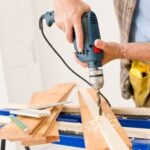Making home improvements can be an exciting project for homeowners, but it’s important to ensure that any changes comply with the Uniform Construction Code (UCC). This code sets out minimum standards for construction and safety in residential and commercial buildings. Understanding how to navigate the UCC is crucial for anyone looking to make changes to their property within the bounds of the law.
Before diving into any home improvement projects, it’s essential to have a basic understanding of what the Uniform Construction Code entails. This includes familiarizing oneself with the scope of home improvements covered by the code, researching local building regulations, obtaining necessary permits, hiring a licensed contractor or determining if DIY is allowed under the code, and conducting inspections to ensure compliance.
Navigating through this process can seem daunting at first, which is why this article aims to provide homeowners with a comprehensive overview of how to make home improvements within the Uniform Construction Code. From understanding the basics of UCC compliance to obtaining necessary permits and conducting inspections, this guide will cover everything you need to know to ensure that your home improvements are done safely and legally.
Whether you’re planning a simple upgrade or a major renovation, following UCC guidelines is essential for protecting your investment and ensuring the safety of your property.
Identifying the Scope of Home Improvements Covered by the Code
Home improvements covered by the Uniform Construction Code (UCC) encompass a wide range of projects, from major renovations to minor alterations. It’s important for homeowners to have a clear understanding of what types of improvements fall under the jurisdiction of the UCC in order to ensure compliance with local building regulations. Here are some examples of home improvements that are typically covered by the code:
- Structural changes, such as adding or removing walls, doors, or windows
- Electrical and plumbing work, including rewiring, installing new fixtures, or relocating plumbing lines
- Alterations to the heating, ventilation, and air conditioning (HVAC) systems
- Roof repairs or replacements
- Additions such as decks, patios, or outdoor structures
When planning any of these projects, it’s essential to consult the UCC guidelines to understand the specific requirements and regulations that apply. By familiarizing yourself with the scope of home improvements covered by the code, you can ensure that your project is conducted in a compliant and safe manner.
Additionally, homeowners should be aware that even seemingly minor improvements may still fall under UCC regulations. For example, installing a new water heater or replacing an existing one may require obtaining permits and inspections to ensure compliance with safety standards. It’s always best to err on the side of caution and research whether your planned improvement falls within UCC jurisdiction before beginning any work.
It is also important for homeowners to understand how their local building department interprets and enforces the UCC guidelines. Different municipalities may have variations in their application of the code, so it’s crucial to do thorough research into your specific area’s regulations before commencing any home improvement project.
This involves contacting your local building department, obtaining copies of relevant codes and ordinances, and seeking clarification on any areas of uncertainty. Understanding these nuances will help you navigate through potential roadblocks when making home improvements within the Uniform Construction Code.
Researching Local Building Regulations and Permits
One of the first steps in making home improvements within the Uniform Construction Code is to thoroughly research local building regulations and permits. Each city or municipality may have its own specific requirements, so it is crucial to understand what is allowed and what is not in your area. This can include zoning laws, historic preservation guidelines, environmental restrictions, and more.
In order to find out the specific regulations for your location, it is recommended to start by contacting your local building department or permit office. They will be able to provide you with information on what types of projects require permits, the necessary documentation needed for approval, and any specific code requirements that must be followed. Additionally, they can often provide guidance on navigating the permit application process and answer any questions you may have.
It is also important to consider seeking legal counsel or consulting with a professional contractor who has experience working within the Uniform Construction Code. They can help clarify any ambiguous language within the code and ensure that your proposed home improvements comply with all relevant regulations.
By doing thorough research on local building regulations and permits and seeking expert advice, homeowners can better understand how to make home improvements within the Uniform Construction Code while avoiding potential legal issues or fines.
Hiring a Licensed Contractor or DIY
When it comes to home improvements within the Uniform Construction Code, homeowners have the option to either hire a licensed contractor or to complete the project themselves. Understanding what is allowed under the code is essential in making this decision. Here are some key points to consider when deciding whether to hire a professional or take on the project as a DIY:
- Hiring a Licensed Contractor:
- Check for licenses and certifications: Before hiring a contractor, it is essential to ensure that they are properly licensed and have the necessary certifications to perform the work within the scope of the Uniform Construction Code.
- Liability and insurance: A licensed contractor will typically carry liability insurance, which provides protection for both the homeowner and the contractor in case of property damage or injury during construction.
- Compliance with building codes: Professional contractors are well-versed in local building regulations and will ensure that all work is completed in compliance with the Uniform Construction Code.
- DIY Home Improvements:
- Understand permit requirements: Before embarking on a DIY project, homeowners must research whether permits are required for the specific improvements they plan to make. Certain types of work, such as structural alterations or electrical upgrades, may necessitate obtaining permits.
- Skill level and expertise: Assessing one’s own abilities and knowledge is crucial when considering taking on a home improvement project as a DIY endeavor. Some tasks may require specialized skills or tools that homeowners may not possess.
- Time commitment: DIY projects often take longer to complete than those handled by professional contractors. Homeowners should factor in their availability and schedule when deciding whether to tackle a project themselves.
Ultimately, whether opting for a licensed contractor or DIY, homeowners must ensure that any home improvements made comply with the Uniform Construction Code. By understanding what is permitted under the code and making informed decisions based on individual circumstances, homeowners can navigate this aspect of home improvement effectively.
Tips for Planning Home Improvements Within the Uniform Construction Code
Planning home improvements within the Uniform Construction Code (UCC) can be a daunting task, but with the right tips and guidance, homeowners can make the process smoother and more manageable. One of the first tips to consider when planning home improvements under the UCC is to thoroughly understand the specific requirements outlined in the code. This may involve conducting research or seeking professional advice to ensure that your planned improvements comply with the UCC.
Another important tip for planning home improvements within the UCC is to establish a clear and detailed plan before starting any construction or renovation work. This includes creating a comprehensive project outline, obtaining necessary permits, and hiring licensed professionals as needed. By having a well-thought-out plan in place, homeowners can avoid potential delays and setbacks during the construction process.
Furthermore, when planning home improvements under the UCC, it is crucial to consider any special considerations or restrictions that may apply to your property or location. This may include zoning regulations, historical preservation requirements, or environmental impact assessments. By proactively addressing these factors in your planning process, you can minimize unexpected obstacles and ensure that your home improvements are completed in compliance with the UCC.
Overall, planning home improvements within the Uniform Construction Code requires careful consideration of all relevant regulations and guidelines. By understanding and following these tips for planning under the UCC, homeowners can navigate through the process more effectively while ensuring that their home improvements meet all necessary code requirements.
Step-by-Step Guide to Obtaining Necessary Permits
One of the most important aspects of making home improvements within the Uniform Construction Code is obtaining the necessary permits. The permit process ensures that all construction work complies with safety and building standards, as dictated by local regulations. Failure to obtain the required permits can result in costly fines and delays in completion. Here is a step-by-step guide to help homeowners navigate the permit process efficiently and effectively.
Step 1: Determine the Necessary Permits
The first step in obtaining permits for home improvements is to determine which permits are required for the specific project. Different types of improvements may require different permits, such as building, electrical, plumbing, or mechanical permits. It is crucial to consult with your local building department or code enforcement office to understand the specific requirements for your project.
Step 2: Prepare the Required Documentation
Once you have identified the necessary permits for your home improvement project, it is essential to prepare all required documentation before submitting your permit application. This may include detailed construction plans, site surveys, engineering reports, product specifications, and other relevant information. Make sure to review the permit application checklist provided by your local building department to ensure that you have all the necessary paperwork in order.
Step 3: Submitting the Permit Application
After gathering all required documentation, it’s time to submit your permit application to the local building department or code enforcement office. Ensure that your application is complete and accurate before submission. In some cases, you may be required to pay a permit fee at this stage. Once your application has been submitted, it will be reviewed by building officials for compliance with construction codes and regulations.
By following this step-by-step guide on obtaining necessary permits for home improvements within the Uniform Construction Code, homeowners can ensure that their projects are compliant with local building regulations and safety standards. Taking the time to navigate the permit process diligently can prevent potential setbacks and ensure a successful outcome for any home improvement project.
Common Pitfalls to Avoid When Making Home Improvements
When making home improvements within the Uniform Construction Code, there are some common pitfalls that homeowners should be aware of in order to ensure a smooth and compliant process. Understanding these pitfalls can help avoid costly mistakes and ensure that the improvements are completed in accordance with the relevant regulations.
Ignoring Local Building Regulations
One common pitfall when making home improvements is ignoring local building regulations. Each municipality may have its own set of regulations and requirements, so it’s important to research and understand these before starting any projects. Failure to comply with local regulations can result in fines, delays, or even the need to undo the work that has already been completed.
Skipping Necessary Permits
Another common pitfall is skipping necessary permits. Many home improvement projects require permits from the local building department, including structural changes, electrical work, plumbing alterations, and more. Skipping these permits can lead to legal issues and difficulty selling the property in the future. It’s essential to determine which permits are required for a specific project and obtain them before starting any work.
Non-Compliance With Code Requirements
Finally, non-compliance with code requirements is a significant pitfall to avoid when making home improvements within the Uniform Construction Code. This includes using substandard materials, improperly installing systems, or not following specific construction techniques outlined in the code. Non-compliance can lead to safety hazards and may also affect insurance coverage for the property.
By understanding and avoiding these common pitfalls, homeowners can ensure that their home improvements are completed within the Uniform Construction Code’s guidelines, ultimately increasing safety and compliance while adding value to their property.
Conducting Inspections and Ensuring Compliance
Once the home improvements have been completed, it is essential for homeowners to schedule a final inspection to ensure that the work complies with the Uniform Construction Code. This step is crucial in ensuring the safety and structural integrity of the improvements. Inspections are typically carried out by local building code officials or third-party inspectors authorized by the regulatory body.
During the inspection, the inspector will assess whether the home improvements meet the requirements set forth in the Uniform Construction Code. This includes evaluating elements such as structural integrity, electrical wiring, plumbing, and overall safety of the improvements. It is important for homeowners to be present during these inspections, as it provides an opportunity to address any potential issues or concerns that may be flagged by the inspector.
In order to pass the inspection and ensure compliance with the Uniform Construction Code, homeowners must be prepared to make any necessary adjustments or corrections identified by the inspector. This may involve working closely with licensed contractors or tradespeople to rectify any non-compliant aspects of the home improvements. Once all necessary corrections have been made, a re-inspection can be scheduled to verify compliance and finalize approval from the regulatory authority.
| Inspection Checklist | Action Needed |
|---|---|
| Structural Integrity | Ensure proper construction techniques and materials are used |
| Electrical Wiring | Verify compliance with electrical codes and standards |
| Plumbing | Check for leaks, proper installation of fixtures, and adherence to plumbing codes |
Resources for Additional Information and Guidance on Uniform Construction Code Compliance
In conclusion, making home improvements within the Uniform Construction Code requires careful planning, research, and adherence to local building regulations. Understanding the scope of home improvements covered by the code is essential for homeowners looking to undertake renovation projects. Researching and obtaining the necessary permits, whether for minor upgrades or major renovations, is crucial in ensuring compliance with the code.
Whether homeowners choose to hire a licensed contractor or tackle the improvements themselves, it’s important to be aware of what is allowed under the Uniform Construction Code. Following the step-by-step guide to obtaining necessary permits can help streamline the process and avoid common pitfalls that may arise during construction.
Additionally, conducting inspections and ensuring compliance with the code are must-do steps for homeowners undertaking home improvement projects. This not only ensures safety and structural integrity but also avoids potential legal issues down the line.
Lastly, homeowners can seek additional information and guidance on Uniform Construction Code compliance from local building departments or online resources provided by regulatory bodies. By following these guidelines and seeking assistance when needed, homeowners can successfully make home improvements within the Uniform Construction Code framework.
Frequently Asked Questions
What Is the New Jersey Uniform Construction Code?
The New Jersey Uniform Construction Code (UCC) is a comprehensive set of regulations that govern construction, renovations, and building safety standards in the state. It ensures that structures are built or renovated to meet safety and environmental requirements.
What Date Was the NJ Uniform Code Approved?
The NJ Uniform Construction Code was first approved on December 31, 1975. This marked the beginning of a standardized set of regulations for construction, renovation, and building safety across the state of New Jersey.
What Renovations Require a Permit in NJ?
In New Jersey, various renovations typically require a permit, including structural changes, electrical work, plumbing alterations, and major renovations that affect the overall layout or integrity of a building. These permits ensure that the work is done according to UCC standards, ensuring safety and compliance with regulations.

I’m thrilled to have you here as a part of the Remodeling Top community. This is where my journey as an architect and remodeling enthusiast intersects with your passion for transforming houses into dream homes.





